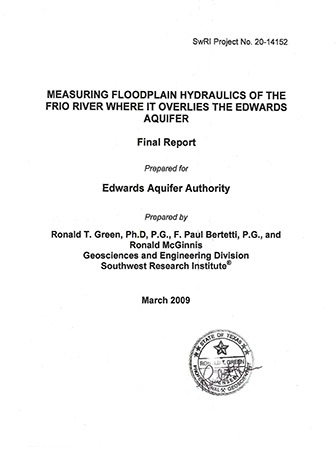Measuring Floodplain Hydraulics of the Frio River Where it Overlies the Edwards Aquifer

| Author | RT Green, FP Bertetti, and R McGinnis |
| Year | 2009 |
| Description | Structural and hydrogeological survey of the Frio River to determine if water table underflow contributes to the water budget of the Edwards Aquifer Recharge Zone |
| Report Number | 20-14152 |
| Publisher | Southwest Research Institute® |
| Location | Frio River, Dry Frio River, Edwards Aquifer Recharge Zone |
| Cover | View Download |
| File | View Download |
| Summary |
|
The purpose of this study was to reduce uncertainty in recharge calculations involving the Frio and Dry Frio rivers by investigating their hydraulic relationship with the Edwards Aquifer. Geophysical imaging of the subsurface of the floodplains of the Dry Frio River and the Frio River did not detect evidence of significant subsurface flow through either paleo-channel deposits or preferential flow pathways developed in the bedrock. In addition, nearby waterholes and wells contain water from infiltrating rainfall and river flow events or upward leakage of relatively saline water. The source of the water is either the Edwards Aquifer or the Austin Chalk rather than subsurface water flowing in the floodplain. Consequently, surface water gauging of river flows in the Frio and Dry Frio Rivers accurately represents the true volume of recharge of the Edwards and related aquifers by recharge in the river channels. The study was completed in May 2009 by Southwest Research Institute, San Antonio, Texas. [Excerpted from the report’s Conclusions] |
Search for Documents
Advance Search
Explore EAA's Scientific Reports
- All Reports
- Modeling
- Hydrology and Hydrogeology
- History
- Groundwater Recharge, Recharge Zone
- Groundwater Movement
- Geomorphology and Caves
- Weather Modification
- Geology
- Water Use and Conservation
- Geochemistry
- Water Resources Planning and Management
- Floods and Drought
- Water Quality
- Climatology
- Surface Water / Groundwater Relationship
- Biology
- Springs, Groundwater Discharge
- Archaeology
- RZ Protection
- Aquifer Levels
- Remote Sensing
- Precipitation
- Overview Studies
